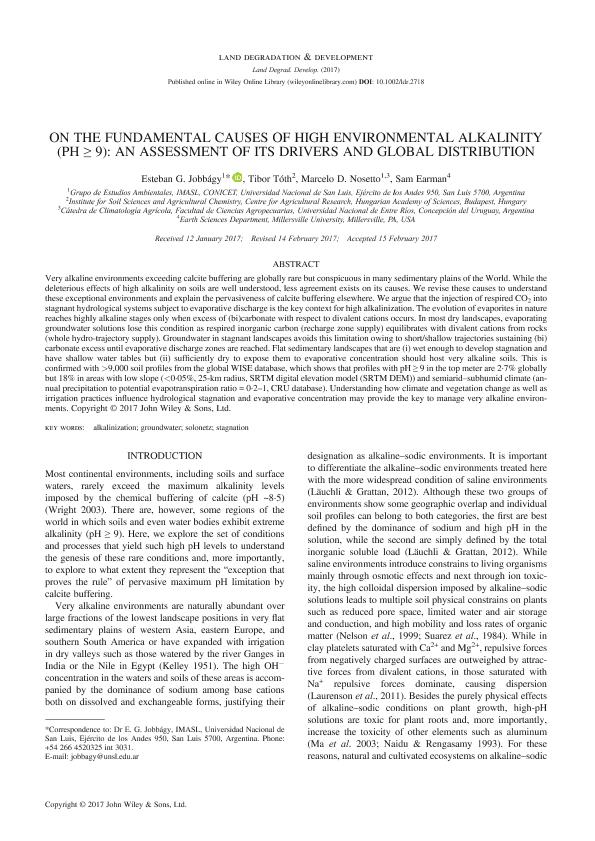Mostrar el registro sencillo del ítem
dc.contributor.author
Jobbagy Gampel, Esteban Gabriel

dc.contributor.author
Tóth, Tibor
dc.contributor.author
Nosetto, Marcelo Daniel

dc.contributor.author
Earman, Sam
dc.date.available
2018-11-26T19:38:08Z
dc.date.issued
2017-10
dc.identifier.citation
Jobbagy Gampel, Esteban Gabriel; Tóth, Tibor; Nosetto, Marcelo Daniel; Earman, Sam; On the Fundamental Causes of High Environmental Alkalinity (pH ≥ 9): An Assessment of Its Drivers and Global Distribution; John Wiley & Sons Ltd; Land Degradation & Development; 28; 7; 10-2017; 1973-1981
dc.identifier.issn
1085-3278
dc.identifier.uri
http://hdl.handle.net/11336/65214
dc.description.abstract
Very alkaline environments exceeding calcite buffering are globally rare but conspicuous in many sedimentary plains of the World. While the deleterious effects of high alkalinity on soils are well understood, less agreement exists on its causes. We revise these causes to understand these exceptional environments and explain the pervasiveness of calcite buffering elsewhere. We argue that the injection of respired CO2 into stagnant hydrological systems subject to evaporative discharge is the key context for high alkalinization. The evolution of evaporites in nature reaches highly alkaline stages only when excess of (bi)carbonate with respect to divalent cations occurs. In most dry landscapes, evaporating groundwater solutions lose this condition as respired inorganic carbon (recharge zone supply) equilibrates with divalent cations from rocks (whole hydro-trajectory supply). Groundwater in stagnant landscapes avoids this limitation owing to short/shallow trajectories sustaining (bi)carbonate excess until evaporative discharge zones are reached. Flat sedimentary landscapes that are (i) wet enough to develop stagnation and have shallow water tables but (ii) sufficiently dry to expose them to evaporative concentration should host very alkaline soils. This is confirmed with >9,000 soil profiles from the global WISE database, which shows that profiles with pH ≥ 9 in the top meter are 2·7% globally but 18% in areas with low slope (<0·05%, 25-km radius, SRTM digital elevation model (SRTM DEM)) and semiarid–subhumid climate (annual precipitation to potential evapotranspiration ratio = 0·2–1, CRU database). Understanding how climate and vegetation change as well as irrigation practices influence hydrological stagnation and evaporative concentration may provide the key to manage very alkaline environments.
dc.format
application/pdf
dc.language.iso
eng
dc.publisher
John Wiley & Sons Ltd

dc.rights
info:eu-repo/semantics/openAccess
dc.rights.uri
https://creativecommons.org/licenses/by-nc-sa/2.5/ar/
dc.subject
Alkalinization
dc.subject
Groundwater
dc.subject
Solonetz
dc.subject
Stagnation
dc.subject.classification
Otras Ciencias de la Tierra y relacionadas con el Medio Ambiente

dc.subject.classification
Ciencias de la Tierra y relacionadas con el Medio Ambiente

dc.subject.classification
CIENCIAS NATURALES Y EXACTAS

dc.title
On the Fundamental Causes of High Environmental Alkalinity (pH ≥ 9): An Assessment of Its Drivers and Global Distribution
dc.type
info:eu-repo/semantics/article
dc.type
info:ar-repo/semantics/artículo
dc.type
info:eu-repo/semantics/publishedVersion
dc.date.updated
2018-10-23T17:38:56Z
dc.journal.volume
28
dc.journal.number
7
dc.journal.pagination
1973-1981
dc.journal.pais
Reino Unido

dc.journal.ciudad
Londres
dc.description.fil
Fil: Jobbagy Gampel, Esteban Gabriel. Consejo Nacional de Investigaciones Científicas y Técnicas. Centro Científico Tecnológico Conicet - San Luis. Instituto de Matemática Aplicada de San Luis ; Argentina
dc.description.fil
Fil: Tóth, Tibor. Hungarian Academy of Sciences. Centre for Agricultural Research. Institute for Soil Sciences and Agricultural Chemistry; Hungría
dc.description.fil
Fil: Nosetto, Marcelo Daniel. Consejo Nacional de Investigaciones Científicas y Técnicas. Centro Científico Tecnológico Conicet - San Luis. Instituto de Matemática Aplicada de San Luis ; Argentina
dc.description.fil
Fil: Earman, Sam. Millersville University; Estados Unidos
dc.journal.title
Land Degradation & Development

dc.relation.alternativeid
info:eu-repo/semantics/altIdentifier/doi/http://dx.doi.org/10.1002/ldr.2718
dc.relation.alternativeid
info:eu-repo/semantics/altIdentifier/url/https://onlinelibrary.wiley.com/doi/abs/10.1002/ldr.2718
Archivos asociados
